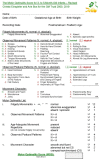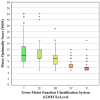Cerebral Palsy: Early Markers of Clinical Phenotype and Functional Outcome
- PMID: 31590221
- PMCID: PMC6833082
- DOI: 10.3390/jcm8101616
Cerebral Palsy: Early Markers of Clinical Phenotype and Functional Outcome
Abstract
The Prechtl General Movement Assessment (GMA) has become a cornerstone assessment in early identification of cerebral palsy (CP), particularly during the fidgety movement period at 3-5 months of age. Additionally, assessment of motor repertoire, such as antigravity movements and postural patterns, which form the Motor Optimality Score (MOS), may provide insight into an infant's later motor function. This study aimed to identify early specific markers for ambulation, gross motor function (using the Gross Motor Function Classification System, GMFCS), topography (unilateral, bilateral), and type (spastic, dyskinetic, ataxic, and hypotonic) of CP in a large worldwide cohort of 468 infants. We found that 95% of children with CP did not have fidgety movements, with 100% having non-optimal MOS. GMFCS level was strongly correlated to MOS. An MOS > 14 was most likely associated with GMFCS outcomes I or II, whereas GMFCS outcomes IV or V were hardly ever associated with an MOS > 8. A number of different movement patterns were associated with more severe functional impairment (GMFCS III-V), including atypical arching and persistent cramped-synchronized movements. Asymmetrical segmental movements were strongly associated with unilateral CP. Circular arm movements were associated with dyskinetic CP. This study demonstrated that use of the MOS contributes to understanding later CP prognosis, including early markers for type and severity.
Keywords: GMFCS; cerebral palsy; dyskinesia; fidgety movements; general movements; hemiplegia; hypotonia; identification; motor optimality score; segmental movements.
Conflict of interest statement
C.E., A.F.B., N.B., L.L., C.P., A.J.S., H.Y., F.F., A.G., and G.C. are certified tutors of the GM Trust; C.M. and A.M. are GM Trust tutors in training. No other disclosures were reported.
Figures




References
-
- Novak I., Morgan C., Adde L., Blackman J., Boyd R.N., Brunstrom-Hernandez J., Cioni G., Damiano D., Darrah J., Eliasson A.C., et al. Early, accurate diagnosis and early intervention in cerebral palsy. Advances in diagnosis and treatment. JAMA Pediatr. 2017;171:897–907. doi: 10.1001/jamapediatrics.2017.1689. - DOI - PMC - PubMed
-
- Einspieler C., Prechtl H.F.R., Bos A.F., Ferrari F., Cioni G. Prechtl’s Method on the Qualitative Assessment of General Movements in Preterm, Term and Young Infants. MacKeith Press; London, UK: 2004. pp. 1–104. - PubMed
Grants and funding
- OPP 1128871/Bill and Melinda Gates Foundation
- P16430/Oesterreichische Nationalbank
- A16-0012/Shaw Research Grant in Nursing and Allied Health Professions
- R15-96/Fondazione Pierfranco e Luisa Mariani
- 15K11705; 18K10748/JSPS KAKENHI
- 1116442/Australasian Cerebral Palsy Clinical Trials Network
- 1153176/National Health and Medical Research Council of Australia, Centre of Excellence
- 1108714/National Health and Medical Research Council of Australia, Career Development Fellowship
- 2019SY032/Shanghai Municipal Commission of Health and Family Planning
LinkOut - more resources
Full Text Sources
Medical
Miscellaneous

